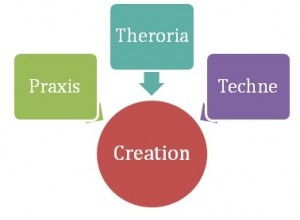Imagination is the beginning of creation. You imagine what you desire, you will what you imagine and at last you create what you will.
-George Bernard Shaw, writer
This is a book about applied creativity in business contexts. The sequence of topics represents a journey. It begins with individuals and later finds expression in teams and organizations.
Organizations are places of poiesis; i.e., production and creation. What is different about this book is that not only do we explore poiesis, but touch on three essential types of knowledge that are the foundation for all creation but usually appear in other contexts (See Figure 1):
- Praxis – knowledge of action and decision making
- Theoria–theoretical knowledge about the world
- Techne – knowledge of art or craft
Theoria pertains to knowledge accruing from a study of the natural world. Praxis pertains to knowledge of the world of action and practice; e.g., medicine. Techne pertains to knowledge about the creation of art or craft.
Business leaders (who are paid to increase production) need to create new products and services. I would argue that the solution to this problem lies in the application of these types of knowledge: Theory, Practice and Craft. So my approach to developing creative high performance people and organizations is to immerse you, the reader, in all of these elements.
Figure 1: Types of Knowledge Essential to Creative Expression

I examine the assets that these domains of knowledge bring and show how they apply to business creation. For example, it has been shown that improvisational models from jazz are relevant to new product development. Modern organizations such as Google and Apple take advantage of the power of design, the role of aesthetics and new emerging models of organization that embrace uncertainty, duality, creativity and even chaos. Experimentation is the cornerstone of science but can also be a means to help organizations to learn. The labors and thought processes of artists, musicians, actors, scientists, writers, and of course, business people, all have helped to construct this new understanding.
However, in the final analysis, the only way to jump-start your organization is by helping people to realize their creative potential. While there has been much emphasis, and rightly so, on leadership in the management literature, the role of the creator has been somewhat over-looked. We need not only great leaders and mangers (i.e., orchestrators) but also great creators. Completing our quartet, we need Knowledge Workers to infuse teams with new data, information, and knowledge, and to help team members to learn.
Creativity is a broad subject that can mean many things. Throughout this book, I highlight specific behaviors associated with creativity; e.g., improvisation, design, experimentation, aesthetic decision making. My fundamental premise is that all of us are creative in some way and have the ability to produce things new and innovative. Everyone. Creativity is not just the province of artists, musicians and writers. We all have creative talents and can learn the behaviors associated with creativity. We can choose to adopt the role of creator; it is not something we are born with. By the time you finish this book I hope to convince you of this point. Great creators aligned with great leaders, great managers, and great knowledge workers are a recipe for success. This quartet can perform at the highest levels.
Eric W. Stein
